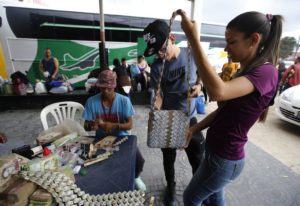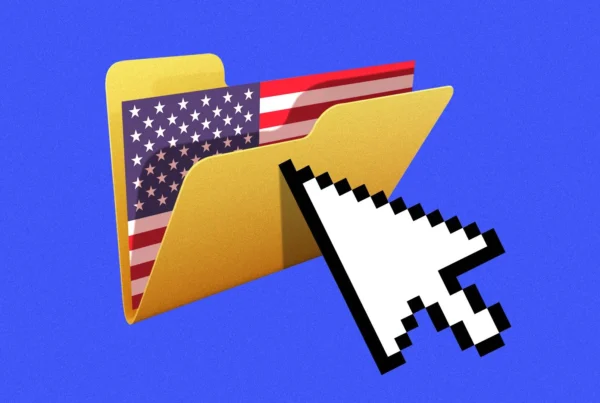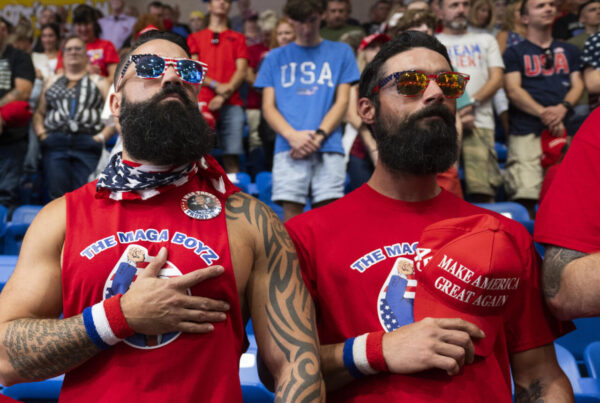By Tomás Le Louarn

Photo of Richard Segovia crafting his bags made up of Bolívares in La Parada, Colombia. February 22nd 2018. Source: AP PHOTO/Fernando Vergara
Richard Segovia, a Venezuelan migrant living in the Colombian border town of Villa Del Rosario, sells fashion accessories on the street to survive, but not just any kind of accessory. Richard sells purses and bags made of Bolívar banknotes, the devalued Venezuelan currency, victim of hyperinflation. Richard tells tales of people giving Bolívares for children to play with, burn them, or even throw them out at sea. “I saw that one really couldn’t buy anything with such a quantity [a wad] of notes so I preferred to do something pretty with them” — he told weekly Colombian magazine Semana. He sells each accessory for around 13 dollars, 130 Bolívares at the official exchange rate but an astonishing 7’930’000 on the black market.
Mr Segovia’s business symbolises the surreal reality of economic ruin and political turmoil Venezuelans are facing. Shortages of basic goods like food and medicine are leaving people queuing in front of supermarkets for hours on end and letting patients die in hospital waiting for treatment. Extreme poverty has nearly risen threefold in 3 years to 61.2% in 2017. According to data from the Venezuelan Social Conflict Observatory, almost ten thousand protests were registered in 2017, more than twenty seven per day. Foreign investment has vanished, inflation rates are the highest in the world, and Caracas, Venezuela’s capital, is the city with the world’s highest murder rates. How did Venezuela get to this point? And how is Nicolás Maduro’s government dealing with the crisis?
The first article in this explainer series will examine Venezuela’s recent history and what led the country to economic collapse.
To understand Venezuela’s downfall one needs to explain its oil boom and the rise of Hugo Chávez and his “21st century socialism” in the country. Situated in South America, Venezuela is fortunate enough to boast the world’s largest oil reserves. Extraction created an economic windfall in the late 20th century, and Venezuela began modernizing itself rapidly. The country received millions of immigrants from neighbouring countries and Europe. Venezuela edged closer and closer to becoming a first world country and was asserting itself as a global player thanks to oil. “La Venezuela Saudita” (Saudi Venezuela) became a commonly used expression.
But Venezuela’s political elite developed what remained an unequal society, with unfair distribution of oil wealth creating two separate realities, where only part of the population truly benefited from the state’s oil rent and lavish spending. Moreover, corruption and red tape were endemic, while successive governments ignoring the economy’s overdependence on oil.
Amid growing social protests in the late 1980’s, Hugo Chávez, a middle ranking military officer at the time, started conspiring with several members of the army to overthrow the government of Carlos Andrés Pérez. This led to a botched coup attempt led by Mr. Chávez in 1992, where he failed to capture Caracas. The event marked the end of the Venezuelan dream and instilled instability in Latin America’s model democracy.
Mr Chávez was sent to jail for two years, but he came out as a man of the people, who stood up for the poor. He had become the face of political change in Venezuela. In 1999, the charismatic former officer became president after a landslide electoral win. “The time for revolution has arrived” — he declared, setting in motion a series of mass nationalizations, welfare programs and social reforms he would call “21st century Socialism”.
Mr Chávez’s government spent billions on these policies. Petrol, electricity and food became subsidized. Enviable free of charge education and health systems were built up. During their time in power the Chavistas reduced poverty by more than half, from a 60% percent poverty rate in 2000 to 26% in 2009. Mr Chávez went on to comfortably win 3 more presidential elections, despite setbacks, democracy was still functioning in Venezuela.
After battling cancer and seeking treatment in Cuba, Mr Chávez still won a 4th term as president in 2012, but died before he could be sworn in. Nicolás Maduro, his vice-president, took over in a bitterly contested election. A former bus driver, Mr Maduro lacked the charisma of his predecessor, and the start of his presidential term in 2013 couldn’t have come at a worse time.
At that moment massive drop in oil prices hit Venezuela’s rent-seeking economy hard. Mr Chávez tenure in power was marred by years of economic mismanagement and anti-market policies, which continued under Nicolás Maduro. This combined with price drop in oil concocted an explosive cocktail. Venezuela’s economy is collapsing, having shrunk by a third since 2013, the steepest collapse in modern Latin American history.
The United Socialist Party of Venezuela, PSUV, saw Venezuela’s national oil company and world class colossus, the PDVSA, as a dairy cow the government could milk carelessly to finance all its policies and social programs. Thanks to Mr Chávez’s nepotism, the number of employees in the company more than doubled to 115’000 workers and PDVSA racked up 90 billion U.S dollars of debt, enough to buy Goldman Sachs or Siemens. Lower productivity, hyper-bureaucracy and lack of investment is killing Venezuela’s “crown jewel”, whose main refinery only runs at 15% capacity.
With all the money already squeezed out from PDVSA, Mr Maduro’s chaotic government is only producing 1.8 million barrels of oil per day, down from a peak of 3.2 million back in 1998, right before Hugo Chávez came to power. If one subtracts oil supplied for almost nothing to Cuba and Caribbean countries and takes away the oil Venezuela is using to pay back its loans from China and Russia, only 750’000 barrels per day are left to sell for cash. These barrels account for a preoccupying 97% of exports after mass expropriations killed the country’s industry.
Mr Maduro’s ingenious solution to mounting debts and oil dependency was printing money, which spurred hyperinflation that exceeded rates of 2600% last year, the highest in the world. All this has led the black market value of the Bolívar to crumble, where it currently trades 641’000 to 1, a staggering difference with the official 10 to 1 rate that only Mr Maduro and his cronies have access to. The problem being that is the official rate is the reference for public salaries in the country. Banknotes are so worthless that Venezuelans don’t know what to do with them, shop owners are starting to weigh the money instead of counting it.
Nationalizations killed the state’s tax income and production while dwindling oil prices put a nail in the coffin. With PDVSA and the state incurring defaults, the government has had to restructure a foreign debt that’s 10 times bigger than its foreign reserves, 105 billion US dollars. The only country to have beaten that figure up until now is Greece.
Mr Maduro’s regime has managed to survive thanks to bonds sold to big banks like Goldman Sachs or states who see a geopolitical interest in the country like China or Russia. Venezuelan bonds are very risky because of the risk of an imminent default. But it is precisely because of this that they have high yields that have attracted banks like Goldman Sachs, which cut a deal with government where it loaned out $865 million for $2.8 billion worth of bonds. This means Venezuela is expected to pay back three times more than it received. Rating agencies have downgraded bonds to default level.
The Chavista regime only does this because time is ticking against its favour and it needs money to pay the police and the army, which can will turn against it if salaries stop being paid. Mr Maduro is so desperate for foreign currency that he cut a deal with China’s Xi Jinping whereby Venezuela will pay back loans to China in the form of oil shipments and unconditional diplomatic support, ironic for a regime that vows to be anti-imperialist.
But even Mr Maduro’s allies are running out of patience. Sinopec, a Chinese oil company, is suing PDVSA for unpaid debts. Even the Cuban government, a consistent ally of the Chavistas, has decided to seize the 49% stake PDVSA held in a Cuban refinery as compensation for unpaid debts. PDVSA also owns numerous other seizable assets abroad, like Citgo, a refiner in the United States, and a fleet of oil tankers in the Caribbean Sea.
Mr Maduro seems lost on how to solve the crisis. His government has started talks with creditors, the problem is he assigned these to Tareck El-Assaimi, his vice–president. Paradoxically, Wall Street bankers cannot do business with him because he is blacklisted by the U.S government for drug trafficking.
Following nationwide currency shortages, the government has also banked in on the cryptocurrency trend and launched one of its own, the Petro. Mr Maduro’s last-ditch attempt to receive foreign currency crucial to imports hasn’t gone well. One Petro is backed by one barrel of oil, the problem is that the oil and the currency are backed by a government which is struggling to extract oil and is incurring default, which is troubling for potential investors.
Venezuela’s government is taking its people into an abyss. Mr Maduro is squeezing the last billions it can out of PDVSA to pay debts at the expense of desperately needed food imports for Venezuelans. This may be a winning strategy for now, but U.S-imposed sanctions and seizures for unpaid debts will start biting back. Mr Maduro is naïve in thinking rising oil prices will save him.
Other posts that may interest you:
- The Trouble with ‘Ecocide’
- Carbon dioxide removal – hit or miss?
- Local Victories for Turkish Opposition — A Sign of Hope?
- Are France and Japan a Mismatch Made in Heaven?
- A Reflection on Dark Tourism
Discover more from The Sundial Press
Subscribe to get the latest posts sent to your email.





